According to Magic The Gathering’s rarity listings, Uncommons are generally more powerful than Commons on average. This, of course, varies between sets and development philosophies within the game. Uncommons have completely warped the game in the past. Some are long-time powerhouses, infamous and feared. Others still are incredibly powerful but endlessly defended by players who insist it is perfectly acceptable. Uncommons have earned themselves the ban hammer in several instances. Others have had the target on their back for years but have managed to evade it.
1. Sol Ring
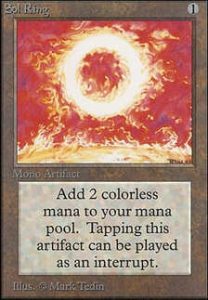
Image Courtesy of Wizards of the Coast
That’s right, Sol Ring. It’s in every single pre-con and was not placed on the Commander Game Changer list. However, it is also banned in Legacy and restricted in Vintage. There have also been increasing cries for Sol Ring to get the axe in Commander as well for creating wildly unfair games. Sol Ring accelerates the cast two turns ahead for one mana. A Sol Ring cast on turn 5 is usually meaningless, but casting it before Turn 3 alters the entire game. For a similar reason, Jeweled Lotus was banned last year in Commander, yet Sol Ring persists.
2. Swords to Plowshares
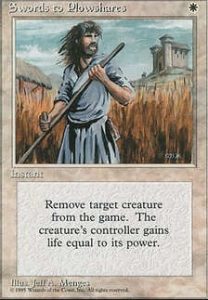
Image Courtesy of Wizards of the Coast
Probably not shocking either; Swords to Plowshares is the best removal spell in Magic the Gathering. Life totals can be reduced, and Plow has reigned as the premiere removal spell in Commander, Legacy, and Vintage. Creating a creature with the card’s text on it completely changed how Modern decks in white were constructed. It’s simply the best, most efficient removal spell Magic has ever seen. Despite their best efforts, they have still failed to top it.
3. Demonic Tutor
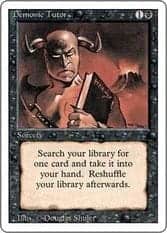
Image Courtesy of Wizards of the Coast
I know what you’re thinking: “Demonic Tutor was an Uncommon?” Yes. It was. The best black tutor, the best black card, period, was printed at Uncommon. This is a card that, regardless of what format I’m playing or what power level of Commander I’m playing. Once someone casts Demonic Tutor, they are the target. Whether assembling a combo, setting up a value play, or grabbing an answer for the current situation, Demonic Tutor is the premiere card to solve any problems.
4. Mental Misstep
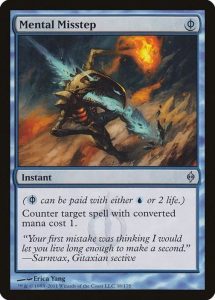
Image Courtesy of Wizards of the Coast
Oh dear, where do I even start with this? Phyrexian mana is probably the second most broken mechanic ever to be introduced to the game, second only to Storm. Mental Misstep is the prime example of why this was such a mistake of a mechanic. Mental Misstep created states in the game where it is most efficient to run Mental Misstep as a 4 of in every deck. It doesn’t matter what colors you are playing or your game plan, at the very least it counters your opponent’s Mental Misstep. It is banned in Legacy and Modern while being restricted in Vintage, and for good reason.
5. Skullclamp
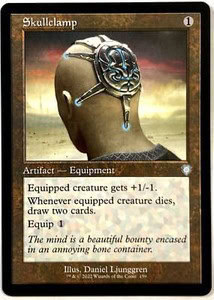
Image Courtesy of Wizards of the Coast
Skullclamp is banned in Legacy and Modern. There are simply too many cards that make 1/1 tokens for Skullclamp to ever be considered a normal card. The card advantage you’re able to build with it is so strong that it had to be slammed with the ban hammer. It is also one of the scariest artifacts an aristocrat playing opponent can cast. The truly crazy thing is that casting it may not even have to occur anymore because you can get Skullclamp with Urza’s Saga.
6. Dragon’s Rage Channeler
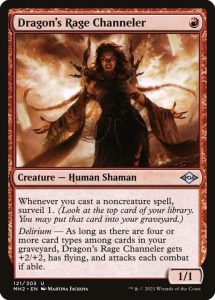
Image Courtesy of Wizards of the Coast
I remember when this card was spoiled. I called up my friends and said, “What is this? Why would they do this?” DRC almost immediately became a premier threat in tempo decks in Modern and Legacy. It retains that spot in Legacy and has fallen out of favor in Modern with the general decline of Izzet Murktide in favor of Dimir Murktide. With DRC, you effectively get a strictly better Delver of Secrets. She offers card selection and a better threat than even Delver could offer.
7. Amped Raptor
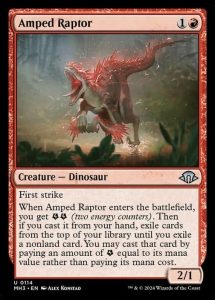
Image Courtesy of Wizards of the Coast
In Modern Horizons 3, there was a huge amount of talk about how pushed the energy strategy was. Amped Raptor embodied this sentiment and became the first card to be banned from the deck. This highly efficient 2-for-1 creature also says First Strike on it, making it hyper-efficient. It was quickly theorized after the reveal that all you needed to do was add some energy synergy, and you could Amped Raptor into The One Ring. Boros Energy was a menace in Modern with these cards, creating overwhelming board states consistently.
8. Expressive Iteration
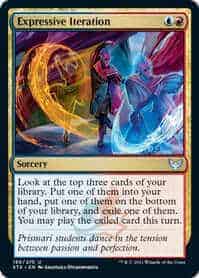
Image Courtesy of Wizards of the Coast
Another efficient 2 for 1, this card was banned in Legacy for making Delver too efficient of a deck. It was also a major card selection spell in Modern until the general replacement of red with black in tempo decks with the arrival of Psychic Frog. It has also faced competition from Questing Druid // Seek the Beast since it offers a similar card advantage as well as a threat. It’s still an objectively powerful Uncommon, seeing as many cards as Ponder and, with the proper deck construction, drawing two cards.
9. Basalt Monolith
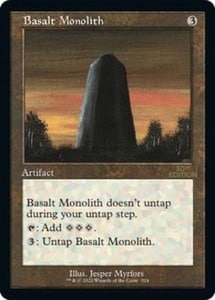
Image Courtesy of Wizards of the Coast
It’s an infinite combo piece extraordinaire. No one who has ever cast Basalt Monolith was doing something fair with it. Zirda, Kinnan, making enormous amounts of mana with keys, Basalt Monolith is an inherently unfair card abused by combo lovers across formats. I’ve been caught with this combo more than once in MTGO Vintage Cube matches. I’ve also suffered against it. Powerful decks trying to make ‘fair’ use of it combine it with keys to make huge amounts of mana and cast other powerful spells ahead of the curve.
10. Up the Beanstalk

Image Courtesy of Wizards of the Coast
Banned in Modern, current Standard all-star, and fringe Legacy banger, the Beans are kind of a menace. It is hard to read this card and understand how powerful it really is. This is generally because no one anticipates triggering it before Turn 5. However, the card still replaces it, so slamming it on Turn 2 is never bad. In practice, there are a lot of cards that cost 5 or more that can be cast for a lot less than 5. It is currently on the B&R Committee’s watchlist for Standard because of how much it allows Domain to do.


